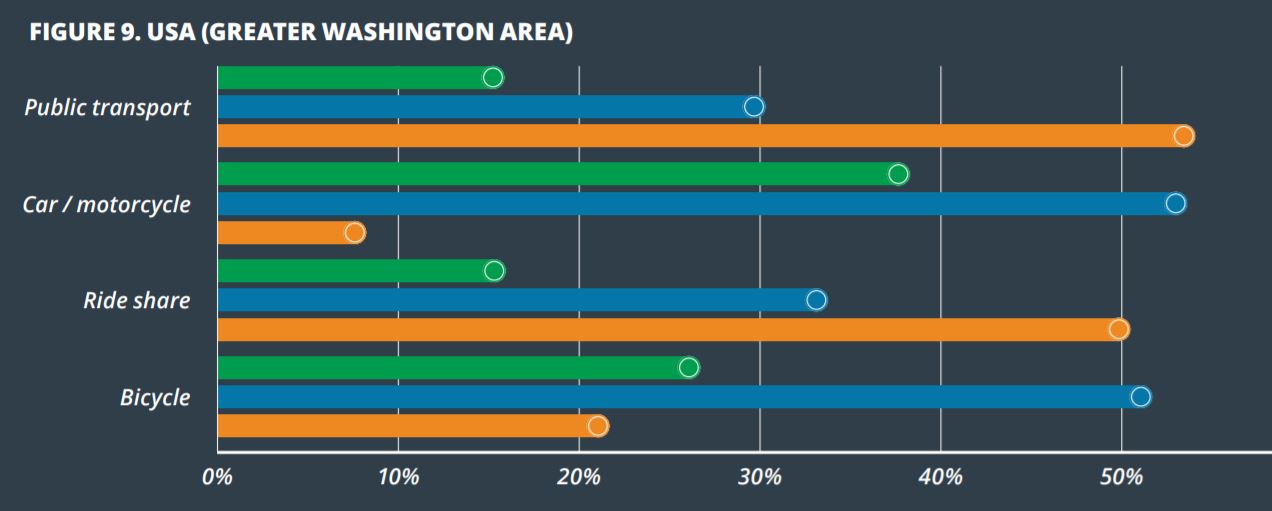
Perceptions of safety on different transportation modes. Green bar = more safe. Blue bar = the same. Orange bar = less safe. Source: “Urban Mobility Trends from COVID-19”
by James A. Bacon
We are taking a break from our regularly scheduled programming about the culture wars to highlight a more traditional topic: government dysfunction. In so doing, we shall contrast the flailing, failing response of a quasi-governmental entity, the Washington Metro, with the proactive, enterprising response of a private toll road operator, Transurban, to the challenge of epidemic-induced declines in traffic.
The Washington Metro, an independent authority governed by a board of directors appointed by three states and the federal government, is a train wreck. For years the commuter-rail and bus system was plagued by maintenance backlogs, a toxic workplace, frequent accidents, deteriorating on-time service, and declining ridership. Then the epidemic hit, and people found it impossible to maintain social distance. Ridership was down 85% in July compared to the same month in 2019… which was down from previous years.
Ridership on the Silver line in Fairfax County is so sparse that it is now practicable for would-be rapists to assault people on trains. Last month a 21-year-old man sexually assaulted a woman who, with her child, was the only other rider in the car. The woman did manage to escape the train at East Falls Church Station, but it won’t bode well for ridership if the public concludes that riding the train is on a par with picking up random hitch-hikers.
Metro has kept the lights on this year thanks to $767 million in federal coronavirus relief funding. But unless Congress approves another round of bail-outs, Metro officials say they may have to cover a $200 million budget shortfall by cutting back capital spending, freezing vacancies, and cutting service — all of which aggravate the underlying problems that drive riders away. Only 25% of Washington Metropolitan Area Transit Authority revenues came from fares. Almost all of the rest came from state-, federal- and local-government taxpayers.
When Metro fails, riders suffer and taxpayers take the hit.
Contrast that with Transurban, the toll road concessionaire for the Washington Beltway, Interstate 95, and Interstate 395. Transurban, an Australian company which owns toll roads and infrastructure projects around the world, took a $111 million loss in fiscal 2020. The company had taken a huge bet that increasing traffic in Northern Virginia (and Australia) would boost revenues from its dynamically priced express lanes.
Traffic on the 95, 395 and 495 Express Lanes hit a low in April when it declined 80% according to the Washington Post. Through mid-June, average daily traffic was still about 60% of pre-pandemic levels.
Now, guess how big of a bail-out Transurban is asking for.
Oh, it’s not asking for a bail-out. So, the answer is zero. Taxpayers are not on the hook for the company’s massive decline in traffic and loss in revenue.
You see, Transurban is managing the company with a multi-decadal perspective, it is diversified, not dependent upon a single revenue stream, and it has access to private equity markets. Indeed, last month the company announced that it intended to sell a financial stake in its U.S. toll roads because it wants to strengthen its balance sheet during the COVID-19 epidemic and have enough cash on hand to bid on new projects.
Transurban has one other advantage over Metro. As the shutdown has eased, riders have returned more quickly to roads and highways than to Metro. One likely reason is, as the chart from a recent Transurban research report indicates (shown above), people are far more likely to feel safe in “cars and motorcycles” than in mass transit or in (Uber, Lyft, etc.) Exclude the motorcycles, and I’d bet that the perception of safety would be a lot higher for just cars.
The long-term threat to Metro and toll roads alike is that more people will work from home. A high percentage of the Washington-area workforce is employed by occupations that can telecommute, and the COVID-19 epidemic has proven that distance working is a viable option for many. More telecommuters means fewer commuters, which means fewer customers for both METRO and toll roads.
If I had to bet who will adapt better to this profoundly adverse trend, I’d lay my money on Transurban. Metro, a permanent ward of the state, has defied all reform efforts, and there is no sign that anything will change.


